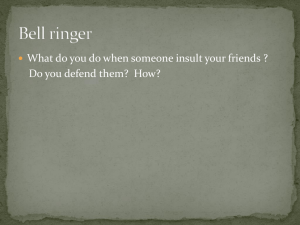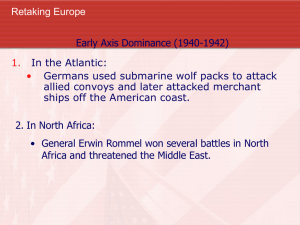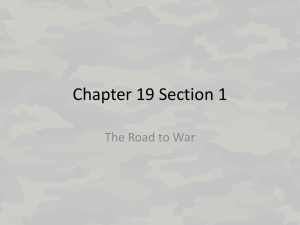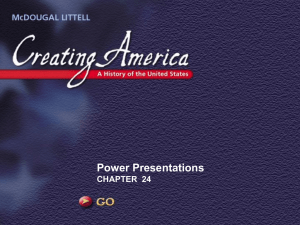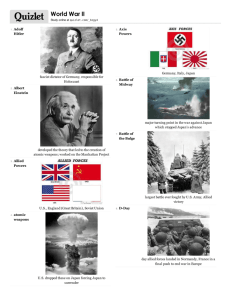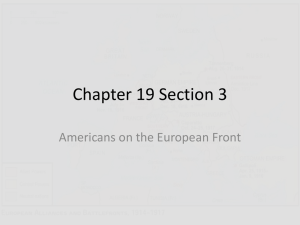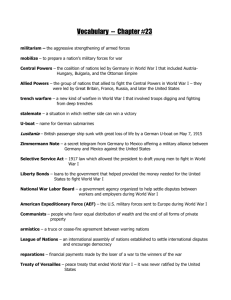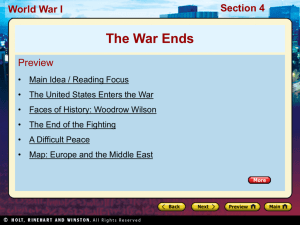World War I Lesson Plan
advertisement
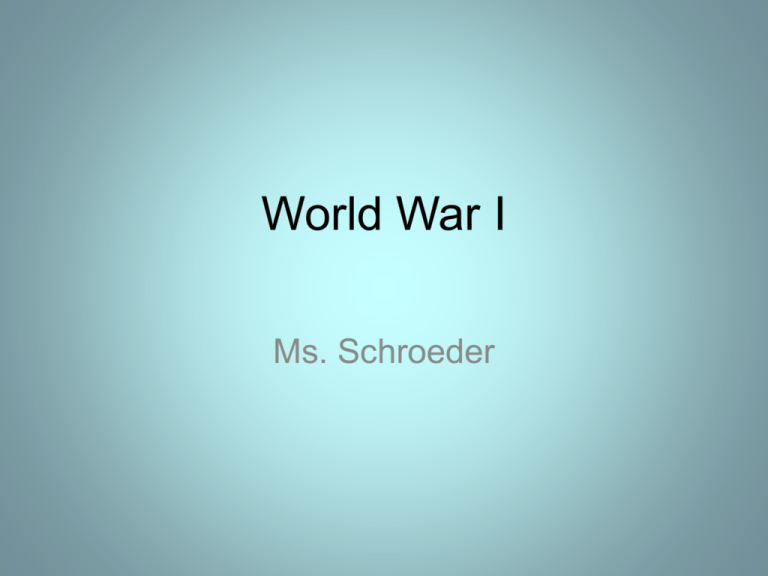
World War I Ms. Schroeder Pictures What We’ll Learn… • Origins of the War • The Central Powers and the Allied Powers – Who were they – Why they were fighting • The United States’ initial position of neutrality and the reasons for later entering the War • The roles of men and women in the War • • • • Strategies used in warfare Death tolls The winners and losers Results of the War • Origins of the War – Militarism, colonialism, and the desire to conquer Europe and other countries – Complicated alliances and defense treaties – The assassination of Archduke Franz Ferdinand • June 28, 1914 – The War began in 1914 and lasted until 1918 The Central and Allied Powers • The Central Powers – Germany, Austria-Hungary, Bulgaria, and the Ottoman Empire • The Allied Powers – Great Britain, Russia, France and Italy (the United States would join the Allies in 1917) From Neutrality to Fighting with the Allies • Originally, President Woodrow Wilson had declared a position of neutrality in the War • The United States continued to trade with both sides • Both powers began to violate the United States’ neutral rights by trying to prevent trade • By 1915, the U.S. had become partial to the Allies and lent money and aid to Great Britain and France The U.S. Sided with the Allies and Joined the War – U.S. had bigger markets with Great Britain and France – Cultural similarities – Perceived notion that Germany was the culprit for the War – German U-Boats attacked U.S. ships and took the lives and property of the U.S. • Sinking of Lusitania – The Zimmerman Telegram • Instruction from Germany to Mexico that should the U.S. fight against Germany, Mexico would attack the U.S. and be monetarily rewarded and receive lost provinces – U.S. began to fear that Europe and even the world could be dominated by Germany if they won – Felt the need to protect American lives and property • The United States abandoned neutrality and entered the War in 1917 • Songs, posters, and other propaganda were used to encourage men to join the service “Over There” written by George M. Cohan and sung by Billy Murray • What is the song about? • What’s the significance? – http://www.firstworldwar.com/audio/overther e.htm Roles, Warfare, Death Tolls, and the Winners and Losers • Roles of men in the War – 24 million young men of 18+ years old were registered by local Selective Service boards – 3 million drafted into the military – 2 million volunteered for service – Relatively few men resisted the draft – Soldiers served on land, sea, or in the air • Roles of women of in the War – Nurses in the War – In the absence of men, women took industrial positions customarily reserved for men – Women also took positions in government war bureaucracies Warfare • Trench – Soldiers dug trenches to protect themselves – The negative aspects of trenches • Disease spread quickly • Dead soldiers and decaying bodies were left in the trenches • Chemical – Poisonous gas attacks – Deadly Trenches were often crowded and unsanitary Dogs used as messengers had to wear canine gas masks to avoid exposure to poisonous gasses • Submarine – German U-Boats and submarine attacks • Use of machine guns and barbed wire – This made defense against and attack easier than staging an offensive • Airplanes and Tanks – Strategists were slow to use airplanes and tanks for offensive use Death Tolls • An estimated 8.5 million soldiers died • Twice the number of those who perished were wounded • Many who were not killed in combat succumbed to disease spread in the trenches • Total casualties of both soldiers and civilians reached 37 million The Winners and Losers • Allied Powers won, Central Powers lost – In September of 1918, millions of Allied troops advanced across the Argonne forest in France and cut German supply lines – In October, troops reached the German border – German leaders asked for armistice (a truce) to be followed by peace negotiations – Having forced the Germans to agree to numerous concessions (something unwillingly admitted), the Allies ended the War on November 11, 1918 Results of the War • Punishment of Germany for its wartime aggression – Allies gave portions of northern Germany to Denmark, and portions of eastern Germany to Poland and Czechoslovakia – Stripped of its entire navy and air force and forbidden to place soldiers in western Germany along the Rhine – Allowed to keep an army of 100,000 men – Forced to admit its responsibility for the war and pay 33 billion to the victors • The Paris Peace Conference and the Treaty of Versailles • Woodrow Wilson’s Fourteen Points and the League of Nations: A new world order – Fourteen Points accepted by both Germany and the Allies as a basis for negotiations for peace – The League of Nations was meant to function as an international parliament and judiciary – Conflict over ratification – Failure and defeat of the Treaty • The U.S. refused to ratify • Failure of the peace process • Created preconditions for another world war – Added to Europe’s problems and delayed the emergence of the U.S. as a leader in world affairs – The Versailles Treaty was neither lenient enough to appease Germany or harsh enough to prevent Germany from becoming a dominant power again • Treaty was not enough to completely neuter the capability of Germany • Allies did not occupy any part of Germany • Created bitter resentment towards the Allies – Germany had to accept their responsibility in the War and assume “war guilt” • Europe – Substantial loss of lives (both of soldiers and civilians) and property – Weakened economy – Weakened military, navy, and air force in Germany • United States – Economy had become the world’s strongest • Became the lenders of money and aid to other countries rather than borrowers • Triggered growth in the 1920’s – Still struggled with class, ethnic, and racial tensions

